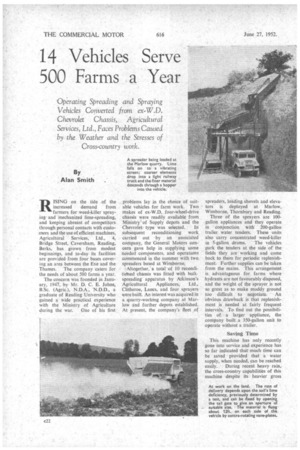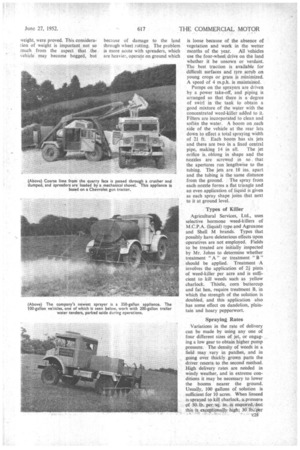14 Vehicles Serve 500 Farms a Year
Page 60

Page 61

Page 62

If you've noticed an error in this article please click here to report it so we can fix it.
Operating Spreading and Spraying Vehicles Converted from ex-W.D. Chevrolet Chassis, Agricultural Services, Ltd., Faces Problems Caused by the Weather and the Stresses of Cross-country work.
By Alan Smith .
RISING on the tide of the increased demand from farmers for weed-killer sprayingand mechanized lime-spreading, and keeping abreast of competitors through personal contacts with customers and the use of efficient machines, Agricultural Services; Ltd., 4, Bridge Street, Cave rsham, Reading, Berks, has grown from modest beginnings, and to-day its facilities are provided from four bases covering an area between the Exe and the Thames. The company caters for the needs of about 500 farms a year.
The concern was founded in January, 1947, by Mr. D. C. E. Johns, B.Sc. (Agric.), N.D.A., N.D.D., a graduate of Reading University who gained a wide practical experience with the Ministry of Agriculture during the war. One of his first
.problems lay in the choice of suitable vehicles for farm work. Two makes of ex-W.D. four-wheel-drive chassis were readily available from Ministryof Supply depots and the
Chevrolet type was selected. In subsequent reconditioning work • carried out by an associated company, the General Motors concern gave help in supplying some needed components, and operations commenced in the summer with two. spreaders based at Wimborne. Altogether, a total of 10 reconditicrned chassis was fitted with bulk
spreading apparatus by Atkinson's Agricultural Appliances, Ltd„ Clitheroe, Lanes, and four sprayers were built. An interest was acquired in a quarry-working company at Marlow and further depots established. At present, the company's fleet of
spreaders, loading shovels and elevators is deployed at Marlow, Wimborne, Thornbury and Reading.
Three of the sprayers are WOgallon appliances and they operate in conjunction with 200-gallon trailer water tenders. These units also carry concentrated weed-killer in 5-gallon drums. The vehicles park the tenders at the side of the fields they are working and come back to them for periodic replenishment. Further supplies can be taken from the mains. This arrangement is advantageous for farms where hydrants are not favourably disposed, and the weight of the sprayer is not so great as to make muddy ground too difficult to negotiate. An obvious drawback is that replenishment is needed at fairly frequent intervals. To find out the possibilities of a larger appliance, the company built a 350-gallon unit to operate without a trailer.
Saving Time
This machine has only recently gone into service and experience has so far indicated that much time can be saved provided that a water supply, when needed, can be reached easily. During recent heavy rain, the cross-country capabilities of this machine despite its heavier gross weight, were proved. This consideration of weight is important not so much from the aspect that the vehicle may become bogged, but because of damage to the land through wheel rutting. The problem is more acute with spreaders, which are heavier, operate on ground which is loose because of the absence of vegetation and work in the wetter months of the year. All 'vehicles use the four-wheel drive on the land whether it be unsown or verdant. The best traction is available for difficult surfaces and tyre scrub on young crops or grass is Minimized. A speed of 4 m.p.h. is maintained. .
Pumps on the sprayers are driven by a power take-off, and piping is arranged so that there is a degree of swirl in the tank to obtain a good mixture of the water with the concentrated weed-killer added to it. Filters are incorporated to clean and soften the water. A boom on each side of the vehicle at the rear lets down to effect a total spraying width of 21 ft. Each boom has six jets and there are two in a fixed central pipe, making 14 in all. The jet orifice is. oblong in shape and the nozzles are screwed in so that the apertures run lengthwise to the tubing. The jets are 18 ins, apart and the tubing is the .same distance from the ground. The spray from each nozzle forms a fiat triangle and an even application of liquid is given as each spray shape joins that next to it at ground level.
Types of Killer
Agricultural Services, Ltd., uses selective hormone weed-killers of M.C.P.A. (liquid) type and Agroxone and Shell M brands. Types that possibly have deleterious effects upon operatives are not employed. Fields to be treated are initially inspected by Mr. Johns to determine whether treatment "A" Or treatment " B " should be applied. Treatment .A involves the application of 24 pints of weed-killer per acre and is sufficient to kill weeds such as yellow charlock. Thistle, corn buttercup and fat hen, require treatment B, in which the strength of the solution is doubled, and this application also has some effect on dandelion, plaintain and hoary pepperwort.
Spraying Rates Variations in the rate of delivery can be made by using any one of four different sizes of jet, or engaging a low gear to obtain higher pump pressure. The density of weeds in a field may .vary in patches, and in going over thickly grown parts the driver resorts to the second method. High delivery rates are needed in windy weather, and in extreme conditions it may be necessary to lower the booms nearer the ground. Usually, 100 gallons of solution is sufficient for 10 acres. When linseed is sprayed to ,kill charlock,a„pressure of so lb per sq rn.. is reqpired4tit this is exceptionally. high; 30'Ibif,Per
sq. in. is normal and the gallonage per acre is usually between 6 and 10.
The spraying season extends through the summer from April until July with peak activity in the intervening months. Economic use of labour is obtained as lime-spreading is carried out during February to April before the spraying season, and August to November afterwards. Neither spraying nor spreading/can be done in 'rainy weather, chiefly because of the damage vehicles may do to the land, and this year's wet spill, soon after Easter, held up spreading for a while so that some of this work impinged on the beginfling of the spraying season. Difficulties were overcome by extra effort exerted by the staff. Weather vagaries are, indeed, the company's chief bugbear. As soon as a fine spell comes along, telephone orders come through to the office in quick succession.
5-ton Spreaders The spreaders are 5-ton machines: A load of 6 tons can be carried if the sides are boarded up another 1 ft. All round. The bodies are hopper-shaped and have two baffles to keep a large proportion of the• weight off the moving belt at the bottom. This takes the lime slowly to the rear through a gate from whence the material drops on to a pair of contra-rotating vane-plates spinning at 500 r.p.m. and is flung some 12 ft. to each side. The rate of delivery can be varied by the depth that the gate is ratcheted open and can be got as low as 2 cwt per acre for spreading certain types of fertilizer for dressing corn.
Farmers requiring lime contact their local merchant and Agricultural Services. Ltd. is called upon to do
• the actual deposition upon the land. The company's technical services, as in the case of weed-killing, can be called upon so that the lime deficiency of the soil, and hence the amount of material required per acre, can be ascertained. This is done either in the laboratory with a specimen or by a spot check.
Spot Check Mr. Johns performed a spot cheek for my benefit, taking a thimbleful of earth and dropping it in a test tube containing barium sulphate. A liquid Colouring agent was added and the contents of the tube were shaken. The resulting solution was green, indicating that the soil was not lacking in lime. Had it been yellow or orange, a deficiency would have been shown, the exact degree of which could have 6een checked by reference to a colour chart..
c24
• To save the specialized appliances from spending needless time on ordinary haulage work, supplies of lime are taken to farms by private hauliers, dumped and shovelled into the spreaders on site as required. Where farms are near quarries, however, the spreaders may load there and run with the material direct to the farm. This practice is always followed, irrespective of distance, when ground burnt lime is being dealt with, as this product burns the skin and cannot be handled.
Lime deficiency varies from county to county. The maximum weight of material ever required per
acre is 10 tons. Normal requirements are 1 ton of ground burnt lime, 2-3 tons of ground limestone or chalk and 3-5 tons of small chalk or waste lime.
The pattern followed by vehicles when spreading in a field is not to make a series of up-and-down runs covering strips adjacent to one another—muchas one would mow a lawn. The degree of driviog skill necessary and restrictions upon vehicle manoeuvrability make it easier to follow a course that can best be described as a series of rectangular loops. The driver runs across the field, then turns at the edge. He proceeds along the fringe for a short distance and turns again to spread another strip some distance from the first. Reaching the other side of the field, he drives back to
near the first deposit, turns, and lays the next strip sb that it abuts the first. The process is repeated over the whole area. The spreading mechanism is cut out when headlands are negotiated.
At the quarry of the Marlow Lime Co., Ltd., which is associated with Agricultural Services, Ltd., a Fordson tractor is employed to rake the strata and loosen it, after which a mobile shovel, based on a Chevrolet artillery tractor, pushes the material on to a conveyor belt. This transfers it to a vibrating screen. Some t'naterial drops through the screen into a hopper, underneath which vehicles may be loaded, whilst coarser elements are allowed to fall into light-railway trucks to be taken to a crusher. Fine material from this machine is held in a dump and vehicles may be loaded from it by means of the Chevrolet shovel.
Maintenance Problems
Operating cross-country vehicles, Agricultural Services, Ltd., is faced with heavy maintenance commit ments. Engines last about six months before they need to be replaced. Little trouble with axles is experienced, but clutch facings wear rapidly. Tyres present another problem. Retreads are apt to strip:
Most service work is done during , the winter when farm operations are mostly at a standstill because of the weather. Stocks of spares are accounted on a system similar to that used in the Army, and some ex-W.D. storage trailers are employed for holding various components and. accessories. A firm near Reading in which Mr. Johns has an interest carries out much service work, besides being responsible for the reconditioning of used chassis. Models of 8-ft. 5-in. wheelbase are selected for conversion into sprayers (which is done by ' this firm), and those of 11-ft, 2-ill. wheelbase for spreading bodies to be fitted. This firm also reconditions Chevrolets for use by various companies at home and abroad.
Personal Attention Agricultural Services, Ltd., owes much of its success to the personal attention it gives to customers' needs. Not only is non-obligatory advice: on spraying and lime-spreading problems offered before any operations are commenced, but subsequent inspections are carried out. Mr. Johns also makes sure that he is familiar with the exact nature of the job of each man on the staff so as to have a full knowledge of the practical side of the business.
















































































































































